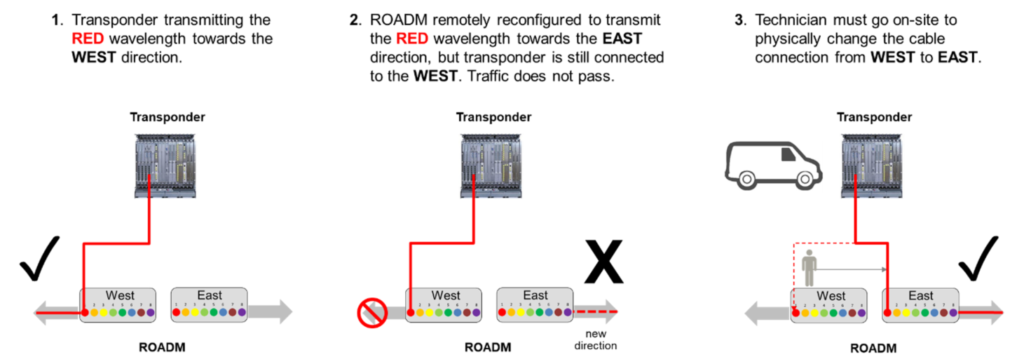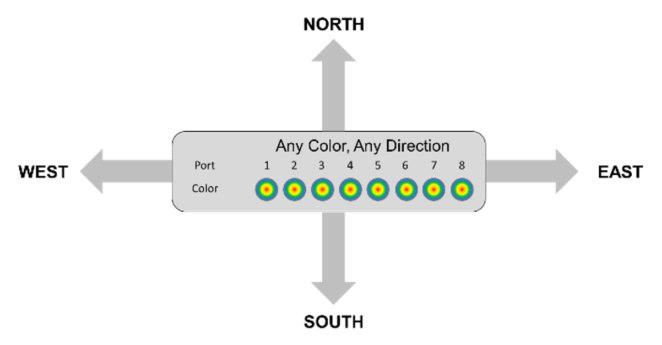The ROADM Tutorial Blogs, part 3

In this series of tutorials I explain the key functionality (and their benefits) that underpin next-generation ROADMs: Colorless, Directionless, Contentionless, and Gridless (CDC-G) functionality.
In this blog, I explain the “D” in CDC-G – Directionless – and the operational benefits it provides.
Before Directionless – the limitations of previous ROADMs
Original ROADM technology dedicated an add/drop complex for each ROADM degree. Remember that one degree is equivalent to one fiber link direction (i.e. one direction = one degree). This means that a transponder had to be physically connected to the add/drop complex dedicated to the direction the wavelength is assigned to. This is illustrated below for a four degree ROADM using North, South, East, and West as the four directions.

A transponder transmitting a red wavelength in the West direction must be connected to the West’s add/drop red port as pointed to by the arrow above. This directional rigidity is cumbersome for the following reasons:
- It requires clear instructions during installation to avoid misconnections – and assumes “as-built” records are up-to-date and correct
- It requires physical intervention for any change of direction and/or wavelength rerouting
- Physical change requirements prevent network automation
Using the same example, what happens when there is a fiber cut in the West direction? Service will be interrupted unless someone visits the site to move the transponder to the mux/demux associated to another direction.
Wavelength Rerouting using SDN Controllers
With the introduction of SDN controllers, service providers can remotely reroute a wavelength to ensure service continuity, but this capability is by itself insufficient to guarantee service survivability in all scenarios.
Many scenarios require a change of direction at the originating/terminating nodes of the wavelength. For this reason, in order to restore services in all scenarios, there is also a requirement to eliminate site visits for the sole purpose of changing the direction of the wavelength.
The scenario below illustrates the manual process of rerouting a wavelength from the West direction to the East direction when using a traditional ROADM.

The Convenience and Flexibility of Directionless Ports
Directionless ROADMs eliminate the 1:1 mapping between the physical add/drop port and the ROADM degree for a specific direction. A single add/drop complex is shared between all the directions and a change of direction does not require any physical reconfiguration.
The directionless capability is typically combined with colorless ports as well in order to eliminate site visits for any type of reconfiguration.

One can almost view the directionless add/drop port as a universal entry point which can be always used, irrespective of the direction the wavelength will take.
With this directionless functionality, the transponder wavelength can be connected to any ROADM port, irrespective of the wavelength direction. The direction of the wavelength can be remotely changed via software. This is now a much easier, quicker, and more cost-effective operation, resulting in significant improvements:
- Simplified installation – any wavelength to any port to any direction
- Elimination of installation errors and possible downtime
- Elimination of site visits by field technicians
- Instantaneous and remote reconfiguration
- Enables network automation

Directionless functionality is supported on all 1FINITY Lambda series blades. This feature is one of the fundamental building blocks for automating the network, reducing operational expenses, reducing downtime, and ultimately increasing customer satisfaction.